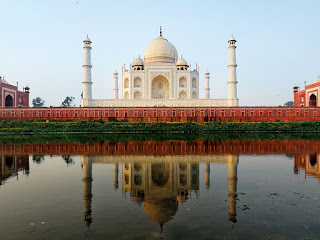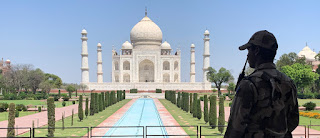History of taj mahal: Pictures, Photos, History & Facts - Agra
history of taj mahal The Taj Mahal is located on the right bank of the Yamuna River in a vast Mughal garden spread over 17 hectares in the Agra district of Uttar Pradesh. It was built by the Mughal emperor Shah Jahan in memory of his wife Mumtaz Mahal in 1632 AD. And was started in 1648 AD. Was completed, including the mosque, guest house, and the main entrance to the south, the outer courtyard, and its walls. Later and 1653 AD. Completed in The existence of several historical and Quranic inscriptions in the Arabic script has facilitated the establishment of the chronology of the Taj Mahal. For its construction, masons, stone cutters, inlayers, carpenters, painters, calligraphers, dome makers, and other artisans were required from across the empire and also from Central Asia and Iran. Ustad-Ahmad Lahori was the chief architect of the Taj Mahal.
all history of taj mahal
The Taj Mahal is considered to be the greatest architectural achievement in the entire range of Indo-Islamic architecture. Its recognized architectural beauty is a rhythmic combination of solids and voids, concave and convex, and light shadows; As arches and domes further, enhance the aesthetic aspect. The green scape Redish Pathway and the blue sky's color combination on it reflect the ever-changing sign and mood in the memorial. The relief work in marble and inlay with precious and semi-precious stones make it a monument apart.
The uniqueness of the Taj Mahal lies in some notable innovations made by Shah Jahan's horticultural planners and architects. One such genius scheme is the construction of the mausoleum at one end of the quadrangular garden rather than the exact center, which added rich depth and perspective to the distant view of the monument. This, too, is one of the best examples of the diversity of raised graves. The mausoleum is erected on a square platform, around which the corners form the octagonal base of the minarets extending beyond the square.
The top of the platform is reached through a lateral flight of steps provided in the center of the southern side. The ground plan of the Taj Mahal is in a perfect balance of composition, with the center having an octagonal tomb room, portal hall, and four corner rooms. The plan is repeated on the upper floor. The exterior of the mausoleum is square in plan with square corners. The large double story vaulted chamber, which houses the Mumtaz Mahal and Shah Jahan's cenotaphs, is an ideal octagon in the plan. The exquisite octagonal marble lattice screen enclosing both cenotaphs is a piece of superb workmanship. more information about the taj mahal in guruunews
It is highly polished and enriched with inlay work. The frame borders are studded with precious stones representing flowers executed with amazing perfection. The colors and shapes of the stones used to make the stones and flowers appear almost real. The cenotaph of Mumtaz Mahal is in the very middle of the tomb room, which is placed on a rectangular platform, decorated with inlaid flower plant motifs. Shah Jahan's cenotaph is larger than Mumtaz Mahal and is located to its west more than thirty years later. The upper cenotaphs are only illusory and the actual graves are in the lower grave chamber (crypt), a practice adopted in royal Mughal tombs.




Comments
Post a Comment